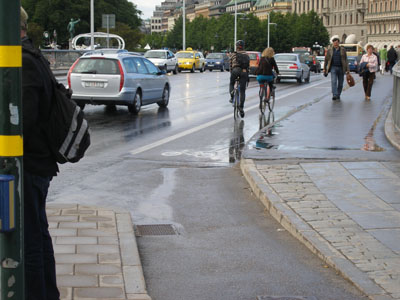Bicycle use in Stockholm has more than doubled over the last 10 years.
Stockholm,
Sweden is a world-class city by any
account, and its multi-modal transportation network contributes to that
status. Its quiet subway system,
vintage trams, and efficient buses are used by 70 percent of commuters traveling
to or from downtown Stockholm during rush hour. But what truly makes Stockholm a tourist
destination and a desired place to live and work is its pedestrian and bicycle
paths that guide people to the train, tram and bus, while also weaving its
transportation network together.

In 1998, Stockholm implemented a
ridership and safety plan that separated bike lanes from traffic, making cycling
safer and encouraging greater bicycle use.
Rather than simply stripe a lane just inches from auto traffic, as is the
norm in most U.S. cities,
Stockholm used
historic-looking brick and cobblestone to create a highly visible divide between
auto traffic and bicyclists along many of its streets. The changes in pavement from smooth
concrete to bumpy surface immediately signals to the motorist a dangerous
incursion into the bike lane.
Stockholm also realized that simply
separating cyclists from traffic would not alleviate car and bike
conflicts. Stockholm re-engineered
some of its busiest intersections to include cobblestone bike cross-paths that
safely allow a bicyclist to traverse the intersection.
The bicycle plan, which was updated
in 2006, not only makes Stockholm’s car, tram,
bus, pedestrian and bicyclist-filled streets truly complete, but also provide
Stockholm’s 1
million residents access to transit stops that may have previously been
inaccessible by bike. This, in
turn, increases transit ridership and decreases the reliance on the automobile
and the need for costly road expansion. As the Chicago region is finalizing its plans for a state capital bill, a
2009 federal surface reauthorization measure, and the Chicago Metropolitan
Agency for Planning’s long-range, 30-year plan (to be released in 2010), bicycle
improvements like those in Stockholm should be a key component of all
transportation and infrastructure proposals.
This article was featured in Talking
Transit, MPC’s bi-weekly e-newsletter. To receive the newsletter, email talkingtransit@metroplanning.org
with ‘Subscribe’ in the subject line.